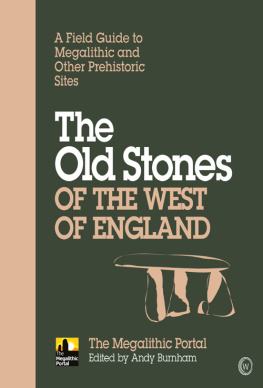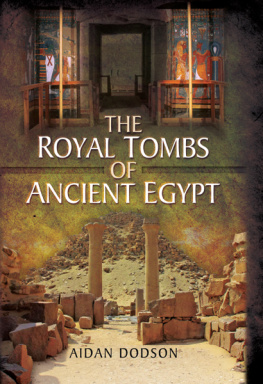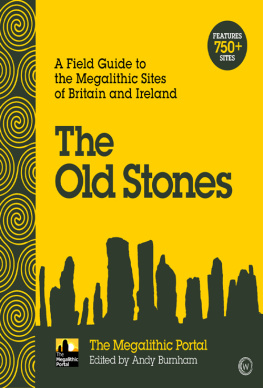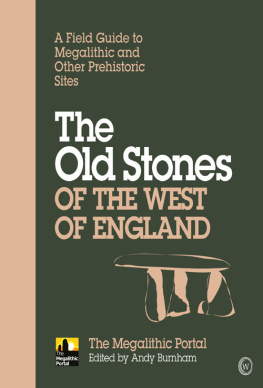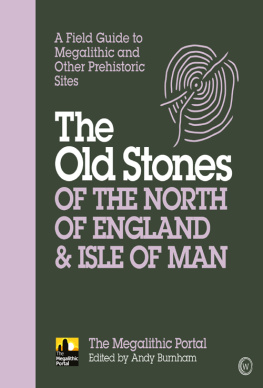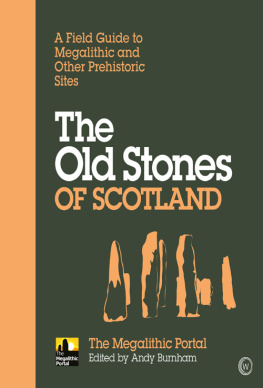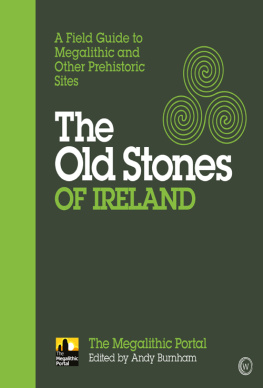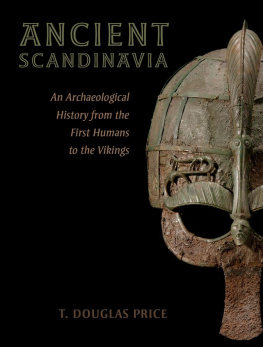Published in the United Kingdom in 2016 by
OXBOW BOOKS
10 Hythe Bridge Street, Oxford OX1 2EW
and in the United States by
OXBOW BOOKS
1950 Lawrence Road, Havertown, PA 19083
Oxbow Books and the individual authors 2016
Hardback Edition: ISBN 978-1-78570-014-9
Digital Edition: ISBN 978-1-78570-015-6
Kindle Edition: ISBN 978-1-78570-016-3
PDF Edition: ISBN 978-1-78570-017-0
A CIP record for this book is available from the British Library
Library of Congress Cataloging-in-Publication Data
Names: Laporte, Luc. | Scarre, Chris.
Title: The megalithic architectures of Europe / edited by Luc Laporte and Chris Scarre.
Description: Oxford : Oxbow Books, 2015. | Includes bibliographical references.
Identifiers: LCCN 2015033850| ISBN 9781785700149 (hardback) | ISBN 9781785700156 (digital)
Subjects: LCSH: Megalithic monuments--Europe. | Tombs--Europe. | Antiquities, Prehistoric--Europe. | Architecture, Prehistoric--Europe. | Neolithic period--Europe. | Europe--Antiquities. | Europe, Northern--Antiquities. | Europe, Western--Antiquities. | Excavations (Archaeology)--Europe, Northern. | Excavations (Archaeology)--Europe, Western.
Classification: LCC GN803 .M473 2015 | DDC 722--dc23 LC record available at http://lccn.loc.gov/2015033850
All rights reserved. No part of this book may be reproduced or transmitted in any form or by any means, electronic or mechanical including photocopying, recording or by any information storage and retrieval system, without permission from the publisher in writing.
Typesetting and layout by Ray Davies
Printed in Wales by Gomer Press
For a complete list of Oxbow titles, please contact:
UNITED KINGDOM
Oxbow Books
Telephone (01865) 241249, Fax (01865) 794449
Email:
www.oxbowbooks.com
UNITED STATES OF AMERICA
Oxbow Books
Telephone (800) 791-9354, Fax (610) 853-9146
Email:
www.casemateacademic.com/oxbow
Oxbow Books is part of the Casemate Group
Front cover: Chambered cairn of Cairnholy, Dumfries and Galloway, Scotland. Photo: Chris Scarre
Contents
Luc Laporte & Chris Scarre
Leonardo Garca Sanjun and Jos Antonio Lozano Rodrguez
Luc Laporte
Noisette Bec Drelon
Florian Cousseau
Vicki Cummings and Colin Richards
Torben Dehn
Chris Scarre
Palle Eriksen and Niels H. Andersen
Jrgen Westphal
Ramn Fbregas Valcarce and Xos Ignacio Vilaseco Vzquez
Jose Antonio Linares Catela
Niels H. Andersen
Anne Birgitte Gebauer
Franziska Hage, Georg Schafferer and Martin Hinz
Primitiva Bueno Ramrez, Rosa Barroso Bermejo and Rodrigo de Balbn Behrmann
Leonor Rocha
Philippe Gouzin
Jean-Marc Large and Emmanuel Mens
Primitiva Bueno Ramrez, Rodrigo de Balbn Behrmann, Luc Laporte, Philippe Gouzin, Rosa Barroso Bermejo, Philippe Gouzin, Florian Cousseau, Antonio Hernanz Gismero and Mercedes Iriarte Cela
Martin Hinz and Wiebke Kirleis
Nicolas Cauwe
Luc Laporte and Primitiva Bueno Ramrez
Chris Scarre and Torben Dehn
Contributors
NIELS H. ANDERSEN
Moesgaard Museum, DK 8270 Hjbjerg, Denmark
RODRIGO DE BALBN BEHRMANN
Area de Prehistoria, Universidad de Alcal, Pza. San Diego, s/n - 28801, Alcal de Henares, Madrid, Spain
ROSA BARROSO BERMEJO
Area de Prehistoria, Universidad de Alcal, Pza. San Diego, s/n - 28801, Alcal de Henares, Madrid, Spain
NOISETTE BEC DRELON
Universit dAix-Marseille, CNRS-MCC, LAMPEA-UMR 7269, Aix-en-Provence, France
PRIMITIVA BUENO RAMREZ
Area de Prehistoria, Universidad de Alcal, Pza. San Diego, s/n - 28801, Alcal de Henares, Madrid, Spain
NICOLAS CAUWE
Muses royaux dArt et dHistoire, Parc du Cinquantenaire, 10, B-1000 Brussels, Belgium
MERCEDES IRIARTE CELA
Departamento de Ciencias y Tcnicas Fisicoqumicas, Facultad de Ciencias, Universidad Nacional de Educacin a Distancia (UNED), Paseo Senda de Rey 9, 28040 Madrid, Spain
FLORIAN COUSSEAU
Universit de Rennes 1-CReAAH UMR6566, 263 Avenue du Gnral Leclerc, Campus de Beaulieu, 35042 RENNES CEDEX, France
VICKI CUMMINGS
School of Forensic and Investigative Science, University of Central Lancashire, Preston PR1 2HE, UK
TORBEN DEHN
Ancient Monuments, Danish Agency for Culture, H. C. Andersens Boulevard 2, DK 1553, Kbenhavn V, Denmark
PALLE ERIKSEN
Ringkbing-Skjern Museum, Herningvej 4, 6950 Ringkbing, Denmark
RAMN FBREGAS VALCARCE
Grupo de Estudos para a Prehistoria do NW Peninsular, Departamento de Historia I, Universidade de Santiago de Compostela, Facultade de Xeografa e Historia, Praza da Universidade, n 1, 15782 Santiago de Compostela, Spain
LEONARDO GARCA SANJUN
Departamento de Prehistoria y Arqueologa, Universidad de Sevilla, Mara de Padilla s/n, 41004, Sevilla, Spain
ANNE BIRGITTE GEBAUER
National Museum, Gammel Carlsbergvej 15, 1799 Kbenhavn V, Denmark
ANTONIO HERNANZ GISMERO
Departamento de Ciencias y Tcnicas Fisicoqumicas, Facultad de Ciencias, Universidad Nacional de Educacin a Distancia (UNED), Paseo Senda de Rey 9, 28040 Madrid, Spain
PHILIPPE GOUZIN
29 rue de La Fontaine, 56420 Plaudren, France
FRANZISKA HAGE
Institut fr Ur- und Frhgeschichte Christian-Albrechts-Universitt, Johanna-Mestorf-Str. 2-6, 24118 Kiel, Germany
MARTIN HINZ
Institut fr Ur- und Frhgeschichte Christian-Albrechts-Universitt, Johanna-Mestorf-Str. 2-6, 24118 Kiel, Germany
WIEBKE KIRLEIS
Institut fr Ur- und Frhgeschichte Christian-Albrechts-Universitt, Johanna-Mestorf-Str. 2-6, 24118 Kiel, Germany
LUC LAPORTE
CNRS Laboratoire Archosciences, Universit de Rennes 1-CReAAH UMR6566, 263 Avenue du Gnral Leclerc, Campus de Beaulieu, 35042 RENNES CEDEX, France
JEAN-MARC LARGE
Archologue associ lUMR 6566 CReAHH, Universit de Rennes 1, Campus de Beaulieu, 35042 Rennes, France
JOS ANTONIO LINARES CATELA
Cota Cero Gestin del Patrimonio Histrico S.L., Calle Antonio Machado, 2, local 2A 21007, Huelva, Spain
JOS ANTONIO LOZANO RODRGUEZ
Instituto Andaluz de Ciencias de la Tierra, Consejo Superior de Investigaciones Cientificas, Universidad de Granada, Avenida de la Palmeras, 4, 18100 Armilla, Granada, Spain
EMMANUEL MENS
Archeo Atlantica, 19 rue du Vieux Moulin 44740 Batz-sur-Mer, France
COLIN RICHARDS
School of Arts, Languages and Cultures, University of Manchester, Manchester M13 9PL, UK
LEONOR ROCHA
Centre de Histria da Arte e Investigao Artstica, Universide da vora, Palcio do Vimioso, Largo Marqus de Marialva 8, 7000-809 vora Portugal
CHRIS SCARRE
Department of Archaeology, Durham University, South Road, Durham DH1 3LE, UK
GEORG SCHAFFERER
Rmisch-Germanische Kommission, Palmengartenstrae 1012, 0325 Frankfurt am Main, Germany
XOS IGNACIO VILASECO VZQUEZ
Grupo de Estudos para a Prehistoria do NW Peninsular, Departamento de Historia I, Universidade de Santiago de Compostela, Facultade de Xeografa e Historia, Praza da Universidade, n 1, 15782 Santiago de Compostela, Spain
JRGEN WESTPHAL
Ancient Monuments, Danish Agency for Culture, H.C. Andersens Boulevard 2, DK 1553 Kbenhavn V, Denmark
Preface
Luc Laporte and Chris Scarre
Megalithic monuments are defined essentially by the unusually large stones employed in their construction. The impressive dimensions have led to recurrent speculation as to how they were built. Popular histories and beliefs frequently attributed them to giants or other mythical beings. Dutch antiquarian Johan Picardt illustrated his Antiquiteten of Drenthe in 1660 with engravings showing giants engaged in the construction of one of the hunebedden of the northern Netherlands (Bakker 2010, 4046). Later scholars, more soberly attributing them to human action, have nonetheless speculated on the precise methods used in their construction by societies lacking modern engineering equipment. Such speculation has concerned both the erection of the monuments the raising upright of a menhir or orthostat, the building of a burial chamber or the addition of a mound and the transport of the stones. The general consensus over the years has envisaged large teams of humans pulling on ropes aided by timber trackways, rollers or scaffolds, although waterborne transport has also been invoked on occasion (for the Stonehenge bluestones, or the Grand Menhir Bris: Atkinson 1979; Le Roux 1997). Winter transport of megalithic blocks over ice or frozen ground has also been suggested for the monuments of northern Europe.
Next page


